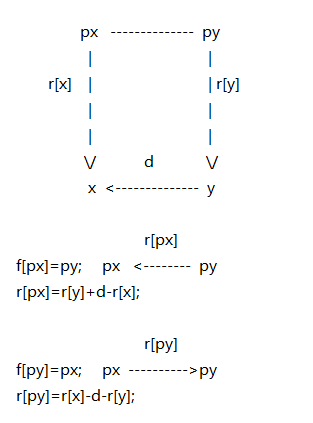Description
Now and then you play the following game with your friend. Your friend writes down a sequence consisting of zeroes and ones. You choose a continuous subsequence (for example the subsequence from the third to the fifth digit inclusively) and ask him, whether this subsequence contains even or odd number of ones. Your friend answers your question and you can ask him about another subsequence and so on. Your task is to guess the entire sequence of numbers.
You suspect some of your friend's answers may not be correct and you want to convict him of falsehood. Thus you have decided to write a program to help you in this matter. The program will receive a series of your questions together with the answers you have received from your friend. The aim of this program is to find the first answer which is provably wrong, i.e. that there exists a sequence satisfying answers to all the previous questions, but no such sequence satisfies this answer.
You suspect some of your friend's answers may not be correct and you want to convict him of falsehood. Thus you have decided to write a program to help you in this matter. The program will receive a series of your questions together with the answers you have received from your friend. The aim of this program is to find the first answer which is provably wrong, i.e. that there exists a sequence satisfying answers to all the previous questions, but no such sequence satisfies this answer.
Input
The first line of input contains one number, which is the length of the sequence of zeroes and ones. This length is less or equal to 1000000000. In the second line, there is one positive integer which is the number of questions asked and answers to them. The number of questions and answers is less or equal to 5000. The remaining lines specify questions and answers. Each line contains one question and the answer to this question: two integers (the position of the first and last digit in the chosen subsequence) and one word which is either `even' or `odd' (the answer, i.e. the parity of the number of ones in the chosen subsequence, where `even' means an even number of ones and `odd' means an odd number).
Output
There is only one line in output containing one integer X. Number X says that there exists a sequence of zeroes and ones satisfying first X parity conditions, but there exists none satisfying X+1 conditions. If there exists a sequence of zeroes and ones satisfying all the given conditions, then number X should be the number of all the questions asked.
Sample Input
10 5 1 2 even 3 4 odd 5 6 even 1 6 even 7 10 odd
Sample Output
3
题意:有一个长度为n的01串,有m句话,每句话说明x到y之间是有奇数(odd)个1还是偶数(even)个1;求的是前几句话是真的;如果全部为真输出m;
每输入一句话时,可以判断是否和之前的话相冲突,用r[i]表示i到i的跟节点之间1的个数是偶数还是奇数,1表示奇数,0代表偶数;
本题的n是10亿,所以不能定义一个10亿的数组;用map<int,int>定义就行


#include<stdio.h> #include<string.h> #include<iostream> #include<algorithm> #include<math.h> #include<map> #define N 105 #define INF 0xfffffff using namespace std; //int f[N], r[N];//r[i]代表i到i的跟节点之间的关系; map<int,int> f; map<int,int> r; int Find(int x) { if(!f[x]) return x; int k = f[x]; f[x] = Find(f[x]); r[x] = (r[x]+r[k])%2; return f[x]; } int main() { int px, py, flag, ans, i, n, m, x, y, d; char str[15]; while(scanf("%d", &n)!=EOF) { flag = 0; f.clear(); r.clear(); scanf("%d", &m); for(i = 1; i <= m; i ++) { scanf("%d%d%s", &x, &y, str); x--; if(str[0] == 'e')//偶数是0;奇数是1; d = 0; else d = 1; px = Find(x); py = Find(y); if(px != py) { f[px] = py; r[px] = (r[y] + d - r[x] +2)%2;//画向量图找关系; } else if(flag==0 && (2 + r[x]-r[y])%2 != d) { flag = 1; ans = i; } } if(flag==0)//如果全部都正确的话输出m;-_-在这wa了一次; ans=m+1; printf("%d ", ans-1); } return 0; }

#include<stdio.h> #include<string.h> #include<iostream> #include<algorithm> #include<math.h> #include<map> #define N 105 #define INF 0xfffffff using namespace std; //int f[N], r[N];//r[i]代表i到i的跟节点之间的关系; map<int,int> f; map<int,int> r; int Find(int x) { if(!f[x]) return x; int k = f[x]; f[x] = Find(f[x]); r[x] = (r[x]+r[k])%2; return f[x]; } int main() { int px, py, flag, ans, i, n, m, x, y, d; char str[15]; while(scanf("%d", &n)!=EOF) { flag = 0; f.clear(); r.clear(); scanf("%d", &m); for(i = 1; i <= m; i ++) { scanf("%d%d%s", &x, &y, str); x--; if(str[0] == 'e')//偶数是0;奇数是1; d = 0; else d = 1; px = Find(x); py = Find(y); if(px < py) { f[px] = py; r[px] = (r[y] + d - r[x]+2)%2;//画向量图找关系; } else if(px > py) { f[py] = px; r[py] = (r[x] - r[y] - d + 2)%2; } else if(px==py &&flag==0 && (r[y] - r[x] + 2)%2 != d) { flag = 1; ans = i; } } if(flag==0)//如果全部都正确的话输出m;-_-在这wa了一次; ans=m+1; printf("%d ", ans-1); } return 0; }
